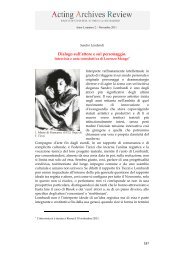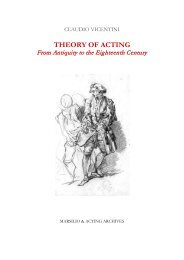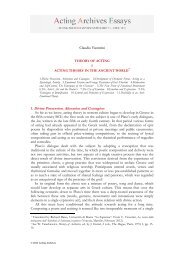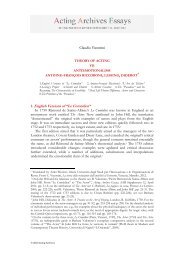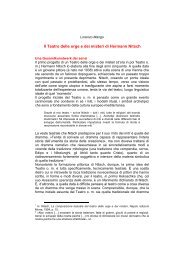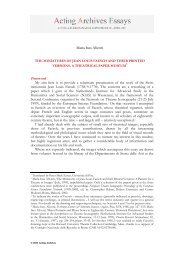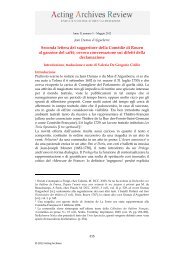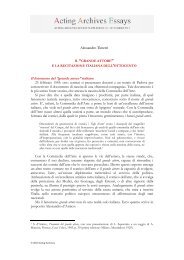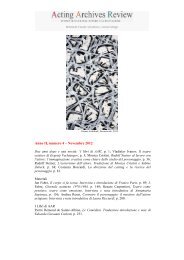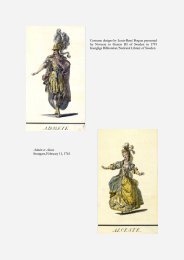Flavia Pappacena_Noverre's Lettres sur la Danse - Acting Archives
Flavia Pappacena_Noverre's Lettres sur la Danse - Acting Archives
Flavia Pappacena_Noverre's Lettres sur la Danse - Acting Archives
You also want an ePaper? Increase the reach of your titles
YUMPU automatically turns print PDFs into web optimized ePapers that Google loves.
AAR <strong>Acting</strong> <strong>Archives</strong> Essays Supplement 9 – April 2011<br />
of the illusion. 81 The contribution of the composer, Noverre added, became truly<br />
effective if he abided by the indications of the choreographer, as had been the case<br />
when Gluck composed the characteristic air of the Ballet des Sauvages for the<br />
production of Iphigénie en Tauride at the Opéra in 1779. 82<br />
Scho<strong>la</strong>rs investigating Noverre have often wondered to what extent these<br />
affirmations are conditioned by his wish to portray himself in the best possible light,<br />
or by a vein of nostalgia for times past, or again what they really mean in technical<br />
terms, and indeed whether the compositions of Deller, Rodolphe, Starzer, Aspelmayr<br />
and Louis de Baillou really were so impressive. 83 In 1760 Noverre argued that the<br />
maître de ballets should have a knowledge of music that extends to practical music<br />
making. In the Programmes he refers to moments in productions involving specific<br />
requisites for the action on stage which would inevitably have p<strong>la</strong>ced strict conditions<br />
on the composer (to give just one example, the specification of silences and<br />
suspense). Moreover, we can find more than one passage in the Programmes which<br />
indicate Noverre’s competence in music (for example, the scene described at the<br />
beginning of the Programme of Psyché in which Psyche is slumbering on a couch<br />
<strong>sur</strong>mounted by a baldachin with the curtains half open, looped up with diamond<br />
bows, <strong>sur</strong>rounded by Graces and Nymphs, allegories of P<strong>la</strong>yfulness, Laughter and<br />
Plea<strong>sur</strong>es, where Noverre suggests the employment of mutes, pizzicati, flutes and<br />
oboes). Even if Noverre’s knowledge of music could not compare with that of<br />
Angiolini, Maximilien and Pierre Gardel or Carlo B<strong>la</strong>sis, he could nonetheless count<br />
on the solid grounding provided as part of dance training. And finally, it should be<br />
borne in mind that when Noverre had to modify the music written for an earlier<br />
ballet, he was not obliged to completely alter its structure to leave the composer a<br />
free hand.<br />
The affinity between dance and painting constitutes, as we have seen, the main<br />
Leitmotiv of the <strong>Lettres</strong>, and one of the cornerstones of Noverre’s aesthetics.<br />
Drawing a parallel between choreographer and artist meant on one hand underlining<br />
the importance of taking a global vision of the stage, and on the other envisaging the<br />
use of the compositional techniques of painting, namely perspective, use of colour,<br />
81 See the entry ‘Ballet’ in Jean-Jacques Rousseau’s Dictionnaire de musique (Paris, Duchesne Veuve,<br />
1768) published by Carlo B<strong>la</strong>sis in 1820 in his Traité élémentaire théorique et pratique de l’Art de <strong>la</strong> danse and<br />
thereafter in The Code of Terpsichore: ‘The music of a dance or ballet must be livelier, and of a stronger<br />
accent and cadence, than vocal music; and as it is required to signify a greater variety of things, it<br />
ought also to be much more diversified. It is music alone that can inspire the dancer and mimic with<br />
that warmth of expression which a singer derives from his words. Music supplies, in the <strong>la</strong>nguage of<br />
the soul, all that dancing, by its attitudes and gestures, cannot make known to the spectators’ (Carlo<br />
B<strong>la</strong>sis, The Code of Terpsichore: a Practical and Historical Treatise on the Ballet, Dancing, and Pantomime; with a<br />
Complete Theory of the Art of Dancing, transl. by R. Burton, London, James Bulcock, 1828; repr. New<br />
York, Dance Horizons, 1976, p. 57).<br />
82 The col<strong>la</strong>boration between the maître de ballets and the composer is amply discussed as early as Letter<br />
V (1760). In the Foreword to the 1803 edition of the <strong>Lettres</strong> Noverre affirms the total subordination of<br />
composer to choreographer (p. 3).<br />
83 Florian Johann Deller and Johann Joseph Rudolph composed the music for the ballets created in<br />
Stuttgart; Joseph Starzer and Franz Aspelmayr those in Vienna; Louis de Baillou col<strong>la</strong>borated with<br />
Noverre in Mi<strong>la</strong>n.<br />
24



